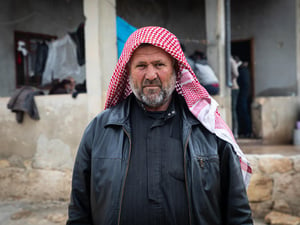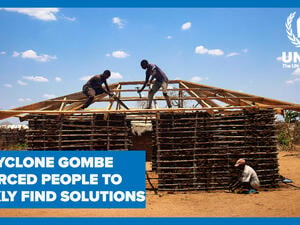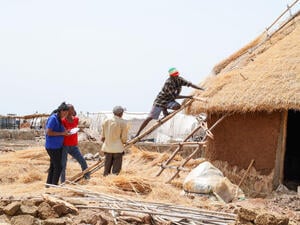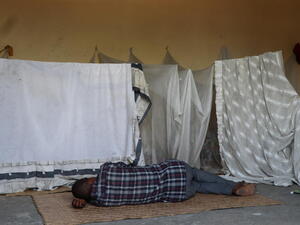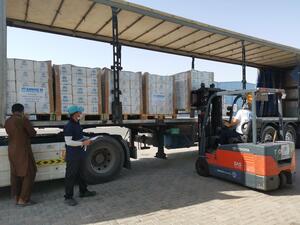UNHCR delivers aid for thousands of Syrian civilians in an embattled suburb of Homs
UNHCR delivers aid for thousands of Syrian civilians in an embattled suburb of Homs

An aid distribution earlier this year in the Azzas area of northern Syria. Reaching out to the needy is difficult inside Syria.
HOMS, Syria, May 28 (UNHCR) - The UN refugee agency has in the past few days delivered aid for thousands of people in an embattled suburb of Homs, Syria's third largest city. The operation focused on people affected by the recent fighting in the Al Wa'er suburb.
On Saturday, blankets, mattresses and household items supplied by UNHCR were distributed to 200 families displaced from Al Wa'er to Homs, which lies in central-western Syria near the border with Lebanon. On Monday, a UNHCR truck carrying humanitarian relief items for 10,000 people arrived in Al Wa'er itself.
The supplies consisted of 5,500 nappies for babies and the elderly, 4,000 sanitary napkins and 2,000 jerry cans. Two additional trucks, carrying 3,000 hygiene kits, had to turn back because of the security situation.
Al Wa'er is home to an estimated 400,000 people, of whom half have been displaced from other areas of Homs governorate - mainly Baba Amer and the old city of Homs.
Heavy clashes between government and opposition forces in Al Wa'er broke out on May 16 and were interrupted by a two-day lull that started on Saturday. Conflict has since resumed. In the course of the recent fighting, at least five buildings hosting hundreds of internally displaced people have been seriously damaged. In one, Alarabaeen Tower, seven members of a single family were killed during mortar attacks. At least seven other people were killed in separate incidents, and UNHCR knows of 32 people having been injured.
The fighting has displaced around 5,000 people, with 250 families having fled to other parts of the city of Homs, where they are staying with relatives. Many of these people have been displaced multiple times. Other displaced people crossed into Lebanon last week: Ten families, comprising 33 people, have registered with UNHCR in Lebanon
A UNHCR team visited one of the IDP shelters in Al Wa'er at the weekend. The shelter, in western Al Wa'er, was hosting 2,100 individuals. The team were told that the shelter had been receiving five families a day since the recent conflict escalation.
"People living there have minimal sanitation, little water and no electricity. Food and medicine were in short supply, and there was an urgent need for mattresses, blankets, and hygiene kits," a UNHCR spokesman said, citing the findings of the team members.
In addition to the focus on trying to deliver additional humanitarian relief to the affected population in and around Al Wa'er, UNHCR is also prepositioning relief items in other areas of Homs itself as a contingency measure for the area.
"UNHCR once again calls on all parties to safeguard the safety and security of the civilian population affected by the conflict. We also reiterate our call for all parties to the conflict to guarantee unhindered access for all humanitarian actors, UNHCR included," the spokesman said.
Elsewhere in the Syria region, UNHCR continues to be concerned about reported impediments in the way of people seeking to cross borders as refugees. Andrew Harper, the UN representative in Jordan, reported on Tuesday morning that some 230 refugees had arrived at Za'atri camp on Monday, with similar numbers at the weekend.
However, crossings are still significantly down from the levels of two weeks ago. Recent problems with border crossings have also been reported along the Syria-Iraq border. It remains essential that civilians seeking to flee insecurity, whether they are internally displaced people or refugees, have safe passage to areas that are outside of harm's way.

